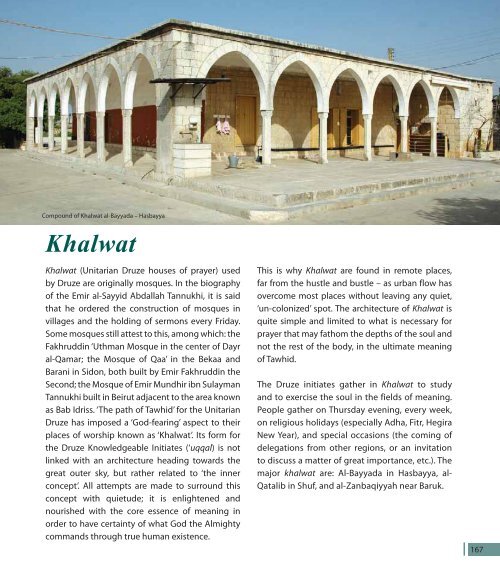Cultural aspects in Christian and Islamic religions - unesdoc - Unesco
Cultural aspects in Christian and Islamic religions - unesdoc - Unesco
Cultural aspects in Christian and Islamic religions - unesdoc - Unesco
You also want an ePaper? Increase the reach of your titles
YUMPU automatically turns print PDFs into web optimized ePapers that Google loves.
Compound of Khalwat al-Bayyada – Hasbayya<br />
Khalwat<br />
Khalwat (Unitarian Druze houses of prayer) used<br />
by Druze are orig<strong>in</strong>ally mosques. In the biography<br />
of the Emir al-Sayyid Abdallah Tannukhi, it is said<br />
that he ordered the construction of mosques <strong>in</strong><br />
villages <strong>and</strong> the hold<strong>in</strong>g of sermons every Friday.<br />
Some mosques still attest to this, among which: the<br />
Fakhrudd<strong>in</strong> ‘Uthman Mosque <strong>in</strong> the center of Dayr<br />
al-Qamar; the Mosque of Qaa’ <strong>in</strong> the Bekaa <strong>and</strong><br />
Barani <strong>in</strong> Sidon, both built by Emir Fakhrudd<strong>in</strong> the<br />
Second; the Mosque of Emir Mundhir ibn Sulayman<br />
Tannukhi built <strong>in</strong> Beirut adjacent to the area known<br />
as Bab Idriss. ‘The path of Tawhid’ for the Unitarian<br />
Druze has imposed a ‘God-fear<strong>in</strong>g’ aspect to their<br />
places of worship known as ‘Khalwat’. Its form for<br />
the Druze Knowledgeable Initiates (‘uqqal) is not<br />
l<strong>in</strong>ked with an architecture head<strong>in</strong>g towards the<br />
great outer sky, but rather related to ‘the <strong>in</strong>ner<br />
concept’. All attempts are made to surround this<br />
concept with quietude; it is enlightened <strong>and</strong><br />
nourished with the core essence of mean<strong>in</strong>g <strong>in</strong><br />
order to have certa<strong>in</strong>ty of what God the Almighty<br />
comm<strong>and</strong>s through true human existence.<br />
This is why Khalwat are found <strong>in</strong> remote places,<br />
far from the hustle <strong>and</strong> bustle – as urban flow has<br />
overcome most places without leav<strong>in</strong>g any quiet,<br />
‘un-colonized’ spot. The architecture of Khalwat is<br />
quite simple <strong>and</strong> limited to what is necessary for<br />
prayer that may fathom the depths of the soul <strong>and</strong><br />
not the rest of the body, <strong>in</strong> the ultimate mean<strong>in</strong>g<br />
of Tawhid.<br />
The Druze <strong>in</strong>itiates gather <strong>in</strong> Khalwat to study<br />
<strong>and</strong> to exercise the soul <strong>in</strong> the fields of mean<strong>in</strong>g.<br />
People gather on Thursday even<strong>in</strong>g, every week,<br />
on religious holidays (especially Adha, Fitr, Hegira<br />
New Year), <strong>and</strong> special occasions (the com<strong>in</strong>g of<br />
delegations from other regions, or an <strong>in</strong>vitation<br />
to discuss a matter of great importance, etc.). The<br />
major khalwat are: Al-Bayyada <strong>in</strong> Hasbayya, al-<br />
Qatalib <strong>in</strong> Shuf, <strong>and</strong> al-Zanbaqiyyah near Baruk.<br />
167

















